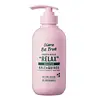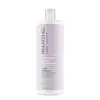What's inside
What's inside
 Key Ingredients
Key Ingredients

 Benefits
Benefits

 Concerns
Concerns

 Ingredients Side-by-side
Ingredients Side-by-side

Water
Skin ConditioningSodium C14-16 Olefin Sulfonate
CleansingCocamidopropyl Betaine
CleansingDisodium C12-14 Pareth-2 Sulfosuccinate
CleansingCocamide Methyl Mea
Sodium Cocoamphoacetate
CleansingSodium Chloride
MaskingPolyquaternium-10
Parfum
MaskingSodium Benzoate
MaskingPolysorbate 20
EmulsifyingCitric Acid
BufferingPhenoxyethanol
PreservativeDisodium EDTA
Sodium Methyl Cocoyl Taurate
CleansingDipropylene Glycol
HumectantPrunus Amygdalus Dulcis Oil
Skin ConditioningArgania Spinosa Kernel Oil
EmollientPEG-7 Glyceryl Cocoate
EmulsifyingButylene Glycol
HumectantGlycerin
HumectantHydrolyzed Pea Protein
EmollientHydrolyzed Quinoa
Skin ConditioningPolyepsilon-Lysine
Skin ConditioningHydrolyzed Corn Protein
Skin ConditioningBrassica Oleracea Acephala Leaf Extract
HumectantWater, Sodium C14-16 Olefin Sulfonate, Cocamidopropyl Betaine, Disodium C12-14 Pareth-2 Sulfosuccinate, Cocamide Methyl Mea, Sodium Cocoamphoacetate, Sodium Chloride, Polyquaternium-10, Parfum, Sodium Benzoate, Polysorbate 20, Citric Acid, Phenoxyethanol, Disodium EDTA, Sodium Methyl Cocoyl Taurate, Dipropylene Glycol, Prunus Amygdalus Dulcis Oil, Argania Spinosa Kernel Oil, PEG-7 Glyceryl Cocoate, Butylene Glycol, Glycerin, Hydrolyzed Pea Protein, Hydrolyzed Quinoa, Polyepsilon-Lysine, Hydrolyzed Corn Protein, Brassica Oleracea Acephala Leaf Extract
Water
Skin ConditioningSodium C14-16 Olefin Sulfonate
CleansingSodium Cocoamphoacetate
CleansingLaureth-5 Carboxylic Acid
CleansingEthoxydiglycol
HumectantPEG-18 Glyceryl Oleate/Cocoate
EmulsifyingPEG-40 Hydrogenated Castor Oil
EmulsifyingVerbascum Densiflorum Flower/Stem Extract
Skin ConditioningHelichrysum Italicum Extract
AntiseborrhoeicCota Tinctoria Flower/Leaf/Stem Extract
Skin ConditioningLinum Usitatissimum Seed Extract
PerfumingOlea Europaea Oil Unsaponifiables
Skin ConditioningSelaginella Lepidophylla Extract
EmollientAmaranthus Caudatus Seed Extract
Skin ConditioningLeuconostoc/Radish Root Ferment Filtrate
AntimicrobialHypnea Musciformis Extract
Skin ProtectingHydrolyzed Pea Protein
EmollientAllantoin
Skin ConditioningLysine Hcl
Skin ConditioningZinc PCA
HumectantProline
Skin ConditioningShikimic Acid
Skin ConditioningSucrose
HumectantCaprylyl Glycol
EmollientAmodimethicone
Glycerin
HumectantPolyquaternium-10
PEG-120 Methyl Glucose Dioleate
EmulsifyingCitric Acid
BufferingC11-15 Pareth-7
EmulsifyingLaureth-9
EmulsifyingPolyquaternium-80
CleansingTrideceth-12
EmulsifyingButylene Glycol
HumectantDisodium EDTA
Trideceth-8
EmulsifyingPotassium Gluconate
Skin ProtectingPhenoxyethanol
PreservativePhenethyl Alcohol
MaskingPotassium Sorbate
PreservativeSodium Gluceptate
Sodium Benzoate
MaskingSalicylic Acid
MaskingParfum
MaskingBenzyl Alcohol
PerfumingWater, Sodium C14-16 Olefin Sulfonate, Sodium Cocoamphoacetate, Laureth-5 Carboxylic Acid, Ethoxydiglycol, PEG-18 Glyceryl Oleate/Cocoate, PEG-40 Hydrogenated Castor Oil, Verbascum Densiflorum Flower/Stem Extract, Helichrysum Italicum Extract, Cota Tinctoria Flower/Leaf/Stem Extract, Linum Usitatissimum Seed Extract, Olea Europaea Oil Unsaponifiables, Selaginella Lepidophylla Extract, Amaranthus Caudatus Seed Extract, Leuconostoc/Radish Root Ferment Filtrate, Hypnea Musciformis Extract, Hydrolyzed Pea Protein, Allantoin, Lysine Hcl, Zinc PCA, Proline, Shikimic Acid, Sucrose, Caprylyl Glycol, Amodimethicone, Glycerin, Polyquaternium-10, PEG-120 Methyl Glucose Dioleate, Citric Acid, C11-15 Pareth-7, Laureth-9, Polyquaternium-80, Trideceth-12, Butylene Glycol, Disodium EDTA, Trideceth-8, Potassium Gluconate, Phenoxyethanol, Phenethyl Alcohol, Potassium Sorbate, Sodium Gluceptate, Sodium Benzoate, Salicylic Acid, Parfum, Benzyl Alcohol
Ingredients Explained
These ingredients are found in both products.
Ingredients higher up in an ingredient list are typically present in a larger amount.
Butylene Glycol (or BG) is used within cosmetic products for a few different reasons:
Overall, Butylene Glycol is a safe and well-rounded ingredient that works well with other ingredients.
Though this ingredient works well with most skin types, some people with sensitive skin may experience a reaction such as allergic rashes, closed comedones, or itchiness.
Learn more about Butylene GlycolCitric Acid is an alpha hydroxy acid (AHA) naturally found in citrus fruits like oranges, lemons, and limes.
Like other AHAs, citric acid can exfoliate skin by breaking down the bonds that hold dead skin cells together. This helps reveal smoother and brighter skin underneath.
However, this exfoliating effect only happens at high concentrations (20%) which can be hard to find in cosmetic products.
Due to this, citric acid is usually included in small amounts as a pH adjuster. This helps keep products slightly more acidic and compatible with skin's natural pH.
In skincare formulas, citric acid can:
While it can provide some skin benefits, research shows lactic acid and glycolic acid are generally more effective and less irritating exfoliants.
Most citric acid used in skincare today is made by fermenting sugars (usually from molasses). This synthetic version is identical to the natural citrus form but easier to stabilize and use in formulations.
Read more about some other popular AHA's here:
Learn more about Citric AcidDisodium EDTA plays a role in making products more stable by aiding other preservatives.
It is a chelating agent, meaning it neutralizes metal ions that may be found in a product.
Disodium EDTA is a salt of edetic acid and is found to be safe in cosmetic ingredients.
Learn more about Disodium EDTAGlycerin is already naturally found in your skin. It helps moisturize and protect your skin.
A study from 2016 found glycerin to be more effective as a humectant than AHAs and hyaluronic acid.
As a humectant, it helps the skin stay hydrated by pulling moisture to your skin. The low molecular weight of glycerin allows it to pull moisture into the deeper layers of your skin.
Hydrated skin improves your skin barrier; Your skin barrier helps protect against irritants and bacteria.
Glycerin has also been found to have antimicrobial and antiviral properties. Due to these properties, glycerin is often used in wound and burn treatments.
In cosmetics, glycerin is usually derived from plants such as soybean or palm. However, it can also be sourced from animals, such as tallow or animal fat.
This ingredient is organic, colorless, odorless, and non-toxic.
Glycerin is the name for this ingredient in American English. British English uses Glycerol/Glycerine.
Learn more about GlycerinWe don't have a description for Hydrolyzed Pea Protein yet.
Parfum is a catch-all term for an ingredient or more that is used to give a scent to products.
Also called "fragrance", this ingredient can be a blend of hundreds of chemicals or plant oils. This means every product with "fragrance" or "parfum" in the ingredients list is a different mixture.
For instance, Habanolide is a proprietary trade name for a specific aroma chemical. When used as a fragrance ingredient in cosmetics, most aroma chemicals fall under the broad labeling category of “FRAGRANCE” or “PARFUM” according to EU and US regulations.
The term 'parfum' or 'fragrance' is not regulated in many countries. In many cases, it is up to the brand to define this term.
For instance, many brands choose to label themselves as "fragrance-free" because they are not using synthetic fragrances. However, their products may still contain ingredients such as essential oils that are considered a fragrance by INCI standards.
One example is Calendula flower extract. Calendula is an essential oil that still imparts a scent or 'fragrance'.
Depending on the blend, the ingredients in the mixture can cause allergies and sensitivities on the skin. Some ingredients that are known EU allergens include linalool and citronellol.
Parfum can also be used to mask or cover an unpleasant scent.
The bottom line is: not all fragrances/parfum/ingredients are created equally. If you are worried about fragrances, we recommend taking a closer look at an ingredient. And of course, we always recommend speaking with a professional.
Learn more about ParfumPhenoxyethanol is a preservative that has germicide, antimicrobial, and aromatic properties. Studies show that phenoxyethanol can prevent microbial growth. By itself, it has a scent that is similar to that of a rose.
It's often used in formulations along with Caprylyl Glycol to preserve the shelf life of products.
Polyquaternium-10 is an ammonium salt of hydroxyethylcellulose. It is a white and granular powder used as a film-former and anti-static agent.
This ingredient is commonly found in hair conditioning products. According to a manufacturer, its positive charge makes it great for absorbing hair proteins. The manufacturer also states this ingredient helps with curl retention.
For haircare friends: this ingredient is not a silicone.
Learn more about Polyquaternium-10Sodium Benzoate is a preservative. It's used in both cosmetic and food products to inhibit the growth of mold and bacteria. It is typically produced synthetically.
Both the US FDA and EU Health Committee have approved the use of sodium benzoate. In the US, levels of 0.1% (of the total product) are allowed.
Sodium benzoate works as a preservative by inhibiting the growth of bacteria inside of cells. It prevents the cell from fermenting a type of sugar using an enzyme called phosphofructokinase.
It is the salt of benzoic acid. Foods containing sodium benzoate include soda, salad dressings, condiments, fruit juices, wines, and snack foods.
Studies for using ascorbic acid and sodium benzoate in cosmetics are lacking, especially in skincare routines with multiple steps.
We always recommend speaking with a professional, such as a dermatologist, if you have any concerns.
Learn more about Sodium BenzoateSodium C14-16 Olefin Sulfonate is a cleansing agent made from a mixture of long chain sulfonate salts. It can also help produce foam.
This ingredient may be drying. We recommend speaking with a professional if you have concerns.
We don't have a description for Sodium Cocoamphoacetate yet.
Water. It's the most common cosmetic ingredient of all. You'll usually see it at the top of ingredient lists, meaning that it makes up the largest part of the product.
So why is it so popular? Water most often acts as a solvent - this means that it helps dissolve other ingredients into the formulation.
You'll also recognize water as that liquid we all need to stay alive. If you see this, drink a glass of water. Stay hydrated!
Learn more about Water